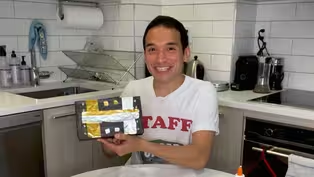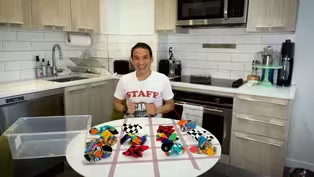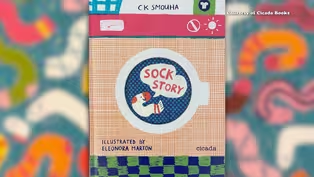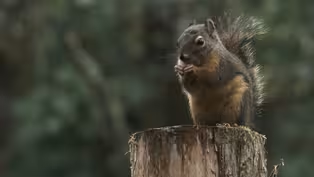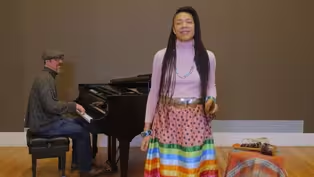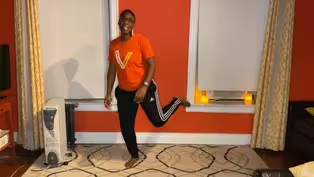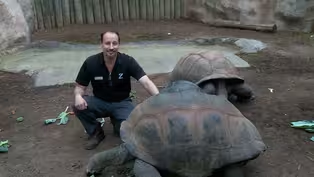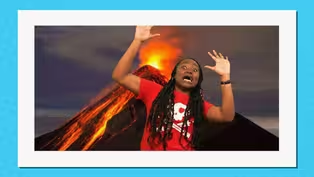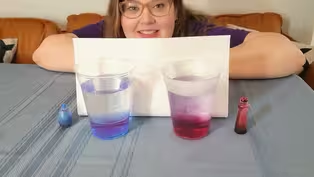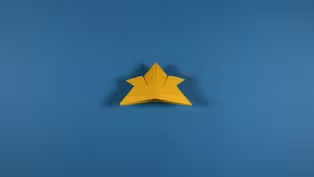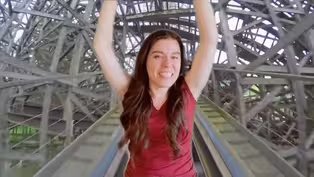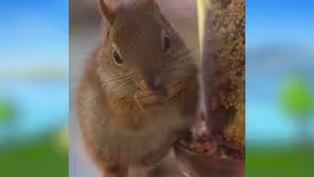
Mismatched Shoe (or Sock!) Day (Long Version)
7/5/2021 | 56m 46sVideo has Closed Captions
Wear shoes or socks that don’t match; read A SOCK STORY!
Join head counselor Zach wearing shoes that don’t match! Ride the rounding roller coaster, make a treasure chest, meet tortoises & squirrels. Content partners include Carnegie Hall, Koo Koo Kangaroo, Liberty Science Center, Memphis Zoo, NJ DOE, New Victory Theater, NY Public Library, San Antonio Zoo Sketch with Jeff at the Guggenheim Museum, Story Pirates, The Metropolitan Museum of Art.
Problems playing video? | Closed Captioning Feedback
Problems playing video? | Closed Captioning Feedback
Camp TV is a local public television program presented by THIRTEEN PBS

Mismatched Shoe (or Sock!) Day (Long Version)
7/5/2021 | 56m 46sVideo has Closed Captions
Join head counselor Zach wearing shoes that don’t match! Ride the rounding roller coaster, make a treasure chest, meet tortoises & squirrels. Content partners include Carnegie Hall, Koo Koo Kangaroo, Liberty Science Center, Memphis Zoo, NJ DOE, New Victory Theater, NY Public Library, San Antonio Zoo Sketch with Jeff at the Guggenheim Museum, Story Pirates, The Metropolitan Museum of Art.
Problems playing video? | Closed Captioning Feedback
How to Watch Camp TV
Camp TV is available to stream on pbs.org and the free PBS App, available on iPhone, Apple TV, Android TV, Android smartphones, Amazon Fire TV, Amazon Fire Tablet, Roku, Samsung Smart TV, and Vizio.
Providing Support for PBS.org
Learn Moreabout PBS online sponsorship- Hi everybody, my name is Zach and welcome to "Camp TV."
Are you ready for some summer fun?
Me too.
Now, as your head counselor I will be introducing you to all sorts of cool activities.
Arts, crafts, games, math, and science as well as some of my favorite books, nature, and theater.
I will be here to take you from one activity to the next.
So follow me on "Camp TV."
[lively music playing] - [Announcer] This program was made possible in part by the Corporation for Public Broadcasting, a private corporation funded by the American people.
Additional funding was provided by the Peter G. Peterson and Joan Ganz Cooney Fund and the Pine Tree Foundation of New York.
[lively guitar music] ♪ Camp TV, it's time for us to start ♪ ♪ From furry animal encounters ♪ ♪ To some reading the arts ♪ ♪ No matter what the weather, we'll explore it all together ♪ ♪ It's a place for you and me ♪ ♪ It's Camp TV ♪ - Step right up campers and welcome.
Have you heard what today is?
If not, let me help you find your footing.
Notice anything different?
Good!
Because today is Mismatched Shoe Day or Sock Day on "Camp TV."
I mean, really, who decided that shoes had to be all matchy matchy and come in pairs?
What about individuality?
Stepping out of your comfort zone, mixing things up.
Do you want to wear a flip-flop with a tap shoe?
Terrific.
A cowboy boot with a slipper?
Yee-haw!
A sneaker with a sandal?
Sweet!
It's high time we celebrate being unique right on down to our tippy toes.
Are you ready to take the road less traveled?
Well, it is right over there and starts with your first activity.
Enjoy.
Jump, dance, play, it's time to get active.
Let's move.
♪ This is my jam ♪ ♪ I love this song ♪ ♪ I move my feet to the beat when its on ♪ ♪ This is my jam ♪ ♪ I love this song ♪ ♪ I move my feet, feet, feet, feet, feet ♪ ♪ to the beat ♪ [upbeat music playing] ♪ I move my feet ♪ ♪ To the beat ♪ ♪ Hey hey ♪ ♪ This is the only song I dance to ♪ ♪ Hey hey ♪ ♪ None of those other tracks can get me hype ♪ ♪ Hey hey ♪ ♪ From this beat you'll only play one tune ♪ ♪ Hey hey ♪ ♪ I'll dance all night ♪ ♪ This is my jam ♪ ♪ I love this song ♪ ♪ I move my feet to the beat when its on ♪ ♪ This is my jam ♪ ♪ I love this song ♪ ♪ I move my feet feet feet feet feet ♪ ♪ to the beat ♪ [upbeat music continues] ♪ I move my feet ♪ ♪ To the beat ♪ ♪ Hey hey ♪ ♪ Like a spirit possessing me ♪ ♪ Hey hey ♪ ♪ I be grinning like a Laugh Attack ♪ ♪ Hey hey ♪ ♪ And I hope that you'll agree ♪ ♪ Hey hey ♪ ♪ Other songs are whack ♪ ♪ This is my jam ♪ ♪ I love this song ♪ ♪ I move my feet to the beat when its on ♪ ♪ This is my jam ♪ ♪ I love this song ♪ ♪ I move my feet, feet, feet, feet, feet ♪ ♪ To the beat ♪ [upbeat music continues] ♪ I move my feet ♪ ♪ To the beat ♪ ♪ When this song is on you know I'ma move my feet like this ♪ ♪ Hey ♪ ♪ Like this ♪ ♪ Hey ♪ ♪ When this song is on you know I'ma move my feet like this ♪ ♪ Hey ♪ ♪ Like this ♪ ♪ Hey ♪ ♪ Hey ♪ ♪ Hey ♪ ♪ This is my jam ♪ ♪ I love this song ♪ ♪ I move my feet to the beat when its on ♪ ♪ This is my jam ♪ ♪ I love this song ♪ ♪ I move my feet, feet, feet, feet, feet ♪ ♪ To the beat ♪ [upbeat music continues] ♪ I move my feet ♪ ♪ To the beat ♪ [lively music playing] - [Zach] Who's ready for a field trip?
- Hello, I'm Brian and welcome to the San Antonio Zoo where we have a lot of animals here at the zoo.
Everything from giraffes, we have bears, [lion roars] lions, rhinos, jaguar, and a lot of flamingo.
[flamingo gabbling] I'm here at the Tiny Tot Nature Spot where we house our Aldabra tortoise exhibit.
Come on, I want you to meet a very special friend of mine.
[lighthearted music playing] - This is Bruno.
He came to us 51 years ago.
These guys could live anywhere from 150 to 250 years.
We don't know exactly how old these tortoises are for sure but we safely say that they're over 100 years old now.
Bruno weighs 450 pounds now and this is Edie that just came to enjoy her breakfast as well.
Edie weighs only 200 pounds and you can see the size difference here between the boys and girls.
[lighthearted music playing] - They eat three times a week, a gallon bucket full of fruits and vegetables.
They do like papaya with the skin on.
- Today for breakfast, they're having kale, some collard greens, a little bit of romaine.
Bruno has pretty good eyesight.
He likes to see some of these brighter colored fruits and vegetables that we give him.
In the wild, they would look for bright colored flowers to eat.
Bruno has this hard shell on him, this is bone, and this has worked great for carrying their house around with them and protecting them from predators.
You see he's got this long neck, he's eating leaves off some branches that are up high, he can stand up and get almost four feet off the ground.
You see he has these big feet upfront to handle his great weight of this 450 pound body of his.
He has scales on the front of his feet here.
You can see how rough those are.
Those help to protect him if he had to pull in his shell and it's real soft up here underneath his shell, and he likes it when we give him a scratch in there.
So you can see the toenails here.
These are made out of keratin just like our fingernails are.
We don't have to do too much to 'em here at the zoo.
If we had one overgrown we could always have the veterinarians come down.
They would trim that back.
But the tortoises walk around enough in their exhibit to wear those down naturally.
This is Bruno's ear right back here behind his eyes.
He doesn't have an ear opening like we do as people.
He has that covered up but he can still hear.
Bruno has no teeth, tortoises and turtles just have a sharp horny beak and it's bone, but it's covered with almost keratin.
It's almost like the same material as your fingernails and it's pretty sharp.
It can bite through different types of fruits and vegetables.
[lighthearted music playing] The difference between a tortoise and a turtle, you see on tortoises here, they have these big feet here almost like elephant feet and they're really spread out to help support the weight of his shell and he has a high-domed shell here as a tortoise.
These guys are designed for being on land.
Turtles, the majority of them are aquatic or like to be in water, and they have a more streamlined shell and a lot of turtles have webbed feet and that helps them be better swimmers.
Are Aldabra tortoises threatened with extinction?
Right now, they're are a few categories up from becoming extinct right now.
They're listed as vulnerable.
There's about 100,000 tortoises left on the Seychelles Islands, where they're from.
When these guys are young they hatch out from eggs that are in between golf ball and tennis ball sized eggs.
Potentially, birds could grab them and fly off with them.
But once these guys get larger they really don't have any other predators except for man.
[lighthearted music playing] Unless you have a lot of space and an unlimited budget to feed these guys, it costs us here at the zoo over $5,000 a year to feed these tortoises.
Smaller tortoises would make better pets, and of course, captive bred tortoises make the best pets.
These guys weighing in at 400 to 600 pounds, they need a lot of space, they need a good sized pool.
They also need a barn at night to get out of the cold weather in.
Like most reptiles, these guys are, you know, they're ectothermic or their temperature inside depends on the temperature outside.
So their body temperatures, they like it to be warmer.
I'd like to thank everybody for coming out to the San Antonio Zoo and meeting my friend Bruno.
- [Zach] Music, dance, magic, and more!
Step right up to "Center Stage."
[lively music playing] ♪ 40 wheels up high on a mountain side ♪ ♪ Covered wagon coming and my people ride ♪ ♪ Walking ♪ ♪ Walking ♪ ♪ Walking ♪ ♪ Walking ♪ [singing in foreign language] - [foreign language] musical explorers.
My name is Martha and this is Aaron on piano.
We are so excited to teach you traditional native American music today.
That song was called "40 Wheels."
It's a song that Aaron and I wrote together about The Trail of Tears, and now we're going to teach you "40 Wheels."
We're going to start by singing the refrain.
I'll sing first and then you'll repeat after me.
Ready?
[singing in foreign language] [slow piano music] ♪ Waya hey ah ha ♪ [slow piano music] ♪ Waya hey ah ha ha ha ha ho ♪ [slow piano music] And that's all you need to know to learn to sing "40 Wheels."
When we sing "40 Wheels," we also use rattles, and now we're going to put it all together.
Ready?
Here we go.
Ready Aaron?
♪ 40 wheels up high on a mountain side ♪ ♪ Covered wagon coming and my people ride ♪ ♪ Walking ♪ ♪ Walking ♪ ♪ Walking ♪ ♪ Walking ♪ ♪ Waya hey ah ha ♪ ♪ Waya hey ah ha ♪ ♪ Waya hey ah ha ha ha ha ho ♪ ♪ Waya hey ah ha ♪ ♪ Waya hey ah ha ♪ ♪ Waya hey ah ha ha ha ha ho ♪ ♪ It was way up high, my great mama cried ♪ ♪ When the calvary took 1000 lives ♪ ♪ Walking ♪ ♪ Walking ♪ ♪ Walking ♪ ♪ Walking ♪ ♪ Waya hey ah ha ♪ ♪ Waya hey ah ha ♪ ♪ Waya hey ah ha ha ha ha ho ♪ ♪ Waya hey ah ha ♪ ♪ Waya hey ah ha ♪ ♪ Waya hey ah ha ha ha ha ho ♪ ♪ Walking ♪ ♪ Walking ♪ ♪ Walking ♪ ♪ Walking ♪ [speaking foreign language] means thank you musical explorers.
You guys did some great singing today.
We don't have a word for goodbye in our native language.
So we just say, [speaking foreign language].
- Welcome back to Mismatched Shoe [ding] or Sock Day on "Camp TV."
[dramatic music playing] So I have a bit of a confession to make and well, it's not something I share with a lot of people but you Camp TV-ers, you are my people.
Um, turns out I can be a bit of a pack rat.
That's someone who holds on to things.
Okay, a lot of things that others might throw out.
Let me show you.
[fast music playing] See?
It's something I'm working on.
But today I'm really glad I held onto this guy.
You know, they say one person's trash is another person's treasure, and they couldn't be more right.
Whoever they are.
Today, we're making a treasure chest, a place where you can keep things that are important to you inside.
You will need a shoe box with an attached lid, some paper fasteners, black paint, a paint brush, some foil paper, glue, and scissors.
First, paint the box black.
Then let it dry.
Next, cut strips of foil and glue them onto the box like this.
With the help of an adult, poke some holes along the sides of the box and put some of the fasteners in.
And finally, add whatever else you'd like to zhuzh it up with.
All set and ready to hold your valuables.
Curiosity and wonder, let's discover together.
It's "Science Wow!"
- Hi there, I'm Jen from Liberty Science Center and I love a nice cold refreshing glass of lemonade after a hot day in the sun.
Cheers.
Hmm.
That's not cold at all.
That's actually pretty hot.
I don't think I like hot lemonade.
I do like hot cocoa though.
But you know, this gets me thinking.
What's the difference between hot and cold water?
What makes hot water hot and cold water cold?
Sounds like something to explore through an experiment.
For this experiment, we'll need two different colors of food coloring and two clear cups filled with equal amounts of hot and cold water.
Now my hot water, I just heated using a kettle and I want to make sure it's equal with my cold water.
That looks good.
Now you could also use a microwave to heat up your water if you'd like.
And my cold water, I've just chilled in the refrigerator.
Now I do want to point out that safety is always top priority when we're doing science.
So it would be a good idea to ask an adult for help anytime you're handling hot water.
Now our goal is to test if our food coloring reacts any different when we add it to our cold water versus our hot water.
So all we have to do is add a few drops to each of our cups.
Now I'm going to just put some white paper behind our cups and hold it up like this so that we can better observe what happens.
So make a prediction.
What do you think will happen when we drop our food coloring in?
Ready, set, go!
All right, let's observe.
What do we see happening?
Hmm.
Do we see any difference in the food coloring, how it's moving?
What's happening with our cold water versus our hot water?
Hmm.
Keep making your observations and your notices.
Does it seem like one of the colors is moving a bit faster?
'Cause that's what I'm noticing.
Let's take another moment to observe.
I'm going to look up close.
I let our cups sit for about 20 seconds and here's what they look like now.
I'm noticing that if this was a race to fill our cups with color, the red food coloring in the hot water definitely would have won.
But why?
And what does that tell us about hot and cold water?
Water, like everything else in our world is made of molecules.
Now in liquids, like water, these molecules move around.
Now the molecules in hot water have a lot of energy and they move around much faster than the ones in cold water that have less energy.
Now, when we add food coloring to water, these moving molecules push it around and spread it out.
So the fast moving molecules in our hot water push around that food coloring faster than the slower moving molecules in our cold water.
Ah, much better.
I added some ice [laughs].
Thanks for joining me scientists.
Bye for now!
[lighthearted music playing] - [Zach] You took the words right out of my mouth.
Right on!
[upbeat music playing] - Once you've got a powerful hero ready to stand up to injustice and save people, it can be tempting to say, "My hero has no weaknesses, they're unstoppable!"
The only problem with that is doesn't make for a very interesting story.
Once, the city was in grave danger as a volcano erupted and spewed out robot dinosaurs who went on a rampage.
But then an unstoppable hero showed up with no weaknesses of any kind and stopped all the bad stuff in like five seconds and had a dance party.
I mean, look, if I was one of the citizens of that town that got saved from all the danger in like five seconds, I'd be thrilled, but that doesn't make for a very interesting story.
To make a story exciting, we want to see characters dealing with incredible challenges, and real danger, and being afraid that they might not make it.
That's what makes a hero brave anyway.
Bravery isn't having no weaknesses and overcoming everything without any problem.
A hero's brave because they're afraid but they do the right thing anyway.
- Come on, you can do this.
Thank you, you're welcome, but do it.
- And besides, it'll be so much more fun for you to write a story where your hero is struggling and there's some drama.
- Oh no, I can't do it.
I'm going to give up.
No, I am the hero!
I must follow through!
I can do this!
- So what kind of weaknesses are you going to give your hero?
It can really be anything.
- I'm really afraid of heights, personally.
I'm also not really good with spiders.
Reminds me of a joke.
What do you get when you mix eight legs and giant teeth?
A spider!
[percussive sting and booing] - And it can help you think of a good problem for your story later if it has something to do with your hero's weaknesses and fears.
Do they not like the heat?
Maybe there's a volcano erupting.
Have they never learned how to swim?
Maybe part of the story will take place on a boat or are they terrified of birds for some reason?
Maybe they have to get a group of friendly eagles to help them solve the problem.
You definitely have permission to get weird with these weaknesses and fears.
- [Zach] Arts and crafts?
Yes please.
Let's get artsy.
[lighthearted music playing] [lighthearted music continues] Ready for some math that counts?
Count on!
- Welcome to the Math Amusement Park.
Yes!
Hey, excuse me, which rides do you recommend that I try first?
- You have to ride the rounding rollercoaster.
Sometimes it goes all the way over and sometimes it doesn't even make it to the top and it goes right back down from where it started.
- Wow, I'm headed there now.
- Wait, wait, wait, not so fast.
You have to know your rounding rules before you ride otherwise you get kicked off.
Do you know them?
It's okay, they have a lesson set up right over there right next to the coaster.
Head there now.
- Thank you so much.
Oh, lesson is right here, okay.
I'm here, it's about to start.
- [Narrator] Welcome to the rounding rollercoaster.
Rounding is when we replace a number with an approximate value so that it's easier to work with.
For example, you might say, "I earned about $20" when actually you earned $22.
You might say, "Yesterday was around 100 degrees outside" when actually it was 96 degrees.
You might say, "I have approximately 10 books in my collection" when actually you have nine.
You see, this is how we use rounding in our everyday lives.
Let me teach you the official rounding rules.
To do that, I'll introduce you to our rounding roller coaster.
This rollercoaster is controlled by the number to the right of the one that we need to round to.
It travels to whatever that number is.
If that number is four or less the rollercoaster will drop back down from where it came from.
If that number is five or greater, the roller coaster will continue on over the hill.
Let's try some practice problems.
If we are rounding 37 to the nearest 10, it will be one of the two tens around it, 30 or 40.
Whichever one 37 is closest to is the answer.
The rounding rollercoaster will help us figure that out.
The number to the right of the tens place is a seven.
That's the number that controls the coaster.
In this case, when the roller coaster travels to seven it will cause it to go all the way to 40.
37 is closer to 40 than 30.
Therefore the answer is 37 rounded to the nearest 10 is 40.
Let's round 135 to the nearest hundred.
The two hundreds are 100 and 200.
The number next to the hundreds place that controls the coaster is three.
In this case, when the coaster travels to three it will not make it to the other side and will fall right back to 100.
Therefore, 135 is closer to 100 than 200.
The answer is 135 rounded to the nearest hundred is 100.
One more thing before you ride the roller coaster, if you get the answer wrong, you can't stay on the ride.
You get kicked off.
Enjoy!
- I got this.
I'm going to go get on the ride.
All right, here's my seat, I'm ready to go.
What's the first question?
- [Narrator] What is 45 rounded to the nearest ten?
- 45 needs to be rounded to the nearest ten.
It'll either round to 40 or it will round to 50.
The number that determines that is the one next to the tens place.
The four is in the tens place and the five is in the ones place.
So the five is going to determine if we go to 40 or 50.
Let's think about the rounding rollercoaster.
The five is on the far side of the coaster, which means that the coaster is going to gain enough speed to go all the way up to 50.
So that means 45 rounded to the nearest ten is 50.
Am I right?
- [Narrator] That answer is correct.
- Here we go [indistinct].
Whoa!
And down!
Whoa!
Woo!
Back to the start.
Oh my goodness.
Okay, what's the next question?
- [Narrator] What is 189 rounded to the nearest hundred?
- If we need to round 189 to the nearest hundreds place it would be either 100 or 200.
Now the number that determines that is the number next to the hundreds place, which is the eight.
And the eight, just like the five from last time is also on the other side of the coaster.
So it looks like we're getting a full ride again.
The answer is 200.
Did I get it?
- [Narrator] That answer is correct.
- And here I go again.
Whoa!
And woo!
Whoa!
Back at the start.
- [Narrator] What is 12 rounded to the nearest ten?
- The next one that we need to do is 12 rounded to the nearest ten.
So the two tens that 12 is between are 10 and 20.
The number that is going to determine whether we go to 10 or 20 is the one next to the tens place in the ones place, which is the two.
So where's two on the rounding rollercoaster?
Oh, two is right in the beginning.
Oh, so that means we're going to go up to two and then we're going to go backwards back down.
The answer is 10.
12 rounded to the nearest ten is 10.
- [Narrator] That answer is correct.
- Okay, here we go.
I'm nervous.
Whoa!
And then we're going to go back down.
Whoa!
- [Narrator] What is 76 rounded to the nearest ten?
- The next question is 76 rounded to the nearest tens place.
Hmm, can you pro students at home figure this one out?
[roller coaster rattling] If you said 80, you are correct.
Okay, let's go.
Whoa!
Woo!
Yes!
- [Narrator] Please come back to the Math Amusement Park soon.
Goodbye.
- Welcome back campers.
I thought that last activity was super cool.
How about you?
Are you feeling like you could now use a break?
Well, why don't you kick up those mismatched shoes or socks and let me take over for a bit.
Who's ready for a Zach challenge?
I will have 10 seconds to try and match these socks and then throw them into the laundry basket.
Okay, let's get 10 seconds on the clock.
And three, two, one.
[whimsical music playing] Oh my gosh, there are so many socks.
[timer buzzing] Ugh!
So close!
Oh, well, wouldn't be the first time I missed getting all my socks into the laundry basket.
And why is there always one sock leftover?
I guess I'll just have to save it for Mismatched Sock Day.
Jump, dance, play.
It's time to get active.
Let's move.
[upbeat music playing] - Hi.
My name is Olney and I am a teaching artist for the New Victory Theater, welcome.
I am here in Brooklyn, New York.
Today, we are going to spend some time exploring some choreography to go-go music.
Ready?
Let's go.
Go-go music originates in Washington, DC and started in the late 60s, early 70s and it's still resonating today.
The dance style that accompanies go-go music is called beat your feet, and we're going to learn a few moves today.
All right.
The first move that we're going to do is the three step kick, okay?
So you're going to start with your right leg going to the right, and you're going to step.
One, step behind with your left leg two, step again, three, kick four.
And when you can I want you to kick like you're kicking a soccer ball, okay?
So you have step, step, step, and a kick, step.
Now going back this way, you're going to step left, right, left, and a kick.
Step, step, step, kick, step, step, step.
Speed it up.
And one, two, three, kick.
One, two, three, kick.
One, two, three, kick, one, two, three, kick.
Awesome.
Next move that we're going to do is called the bop-boppity.
Yep, that's right.
I said it's called the bop-boppity.
And this one is a lot of fun.
So your feet are apart, and we're going to start with our right leg and your arm is going to come up and you're going to heel, heel, and then you're going to switch.
Heel, heel.
Switch, heel heel to your left leg, heel heel.
Let's go a little bit faster.
Heel and a heel and a heel and a heel and a heel, heel, heel, heel.
Nice!
The next move we're going to work on is called the bounce.
It's a bounce.
So we're going to add some arms to it and you're going to go one and a two, clap, one and a two, clap.
One and a two, clap.
One and a two, clap.
One and two, [claps] one and two.
[claps] All right, let's put all three moves together.
So we're going to start with our three step kick into our into our bop-boppity, into our bounce and clap.
Here we go.
Five, six, seven and one, two, three, kick, one, two, three, kick, one, two, three, kick, one, bop-boppity!
And one, two, three, four, five, six, seven, eight, one two, three, four, five, and to our bounce.
Bounce together, [hands clapping] bounce together, [hands clapping] bounce together, [hands clapping] bounce together.
[hands clapping] Let's try that with some music.
[go-go music playing] How does the music make you want to move?
With your shoulders?
What about your hips?
What about your knees?
What about your arms?
What about your feet?
What move can you come up with that's your own?
Practice that move and we're going to add it on to the end choreo.
All right, let's do it one time slow and then we'll do it up to speed.
Here we go, five, six, seven, eight.
And now a one, two, three, kick.
One, two, three, kick.
One, two, three, kick.
One, two, three, kick.
And a one, two, one, two, one, two, one, two, one.
Let's go into the bounce, here we go.
And a bounce, together, [hands clapping] and a bounce, together, [hands clapping] and a bounce.
[hands clapping] How'd you do?
All right, let's try it up to speed.
Five, six, five, six, seven, eight, and a one.
[go-go music playing] Bounce.
Add your own move now.
How'd you do?
This time grab a friend.
You ready?
Five, if you don't have a friend, you do it again.
Six, ready here we go.
And a one!
And bounce.
Do your own move!
Did you guys have a good time today?
I hope you did.
Keep dancing and I'll see you next time.
- [Zach] Arts and crafts?
Yes, please.
Let's get artsy.
- Hi and welcome to "Sketch with Jeff."
Today, I'm thinking about eggs.
Why am I thinking about eggs?
Well, eggs have a very unique shape that is used in drawing.
In fact, I received a note from a friend named Mr.
Egg.
Mr.
Egg was worried that I spend a lot of time talking about other shapes and he wanted to make sure that we didn't forget the shape of an egg.
Now, how would I describe the shape of an egg?
Well, it's not quite an oval.
It's like an oval, but it's a little pointer on one end and a little rounder on the other, and that egg shape is really great for starting a drawing, especially if you're drawing a face.
Let's go to the Guggenheim Museum and take a look.
Come on.
Whenever I see a portrait like this one by the artist Manet, I wonder if the artist started with an oval or egg shape first.
I wonder the same thing about this portrait by the artist, Modigliani.
If I look closely, I can really see that there is an egg or oval shape to both of the faces.
Weren't some of those artworks eggs-traordinary?
I'm sorry, I had to say it.
I am inspired though.
I'm inspired to make my own drawings and I'm going to start with the shape of an egg, kind of an oval, but not quite.
Come with me, let's go to my drawing board, come on.
It's time for an egg-a-thon!
That means we are going to be drawing lots of pictures inspired by an oval or the shape of an egg.
First up is a fox.
[upbeat music playing] Next up, a lady bug.
[upbeat music continues] I think this oval or egg shape is going to become a cute bird.
[upbeat music continues] And this egg shape is the start of a very interesting guy's body.
Look at him.
I don't know, maybe he's a magician, what do you think?
[upbeat music continues] And how can we draw egg shapes and not include Humpty Dumpty?
Of course, this is right before he falls off a wall.
I'm going to add a little bit of shading with my crayon and I think I'm going to add a little bit of color.
I've got a nice red crayon.
I definitely need some red for the lady bug and of course, a little bit for the Fox.
As I look back, I can see my oval shape in all the characters Humpty Dumpty, this magician, of course, the bird and the lady bug and my fox.
Ovals and egg shapes everywhere.
Wow, that was really egg-xiting.
I'm sorry.
I did it again.
I just can't help myself.
You know, I wonder if my friend Pencil has sketched with eggs or used eggs as part of the beginning of a sketch.
Oh, Pencil, what do you think?
- I love eggs.
But there are [indistinct] chickens.
[chickens clucking] - Well, all I can say is whatever Pencil draws is always egg-tra special.
My challenge for you this week is for you to use the shape of an egg as the start for a drawing.
You could use it to draw a face or a head or you could use it to draw the body of a character, or you can use it to construct anything that you want as long as the beginning point is that egg shape.
I think I'm going to share one of my favorite egg jokes with my friend, Mr.
Egg.
What is an egg's least favorite day of the week?
It's Friday.
Get it?
Fry day.
[laughter] - Yeah, you crack me up.
- All right, enough of these egg jokes.
You know, I'm not egg-xaggerating when I say it's been a lot of fun to share these sketches with you and I hope to see you soon.
Take care.
And chickens go [clucking].
- [Zach] Who's ready for a field trip?
- Hi friends, and welcome to the Memphis Zoo.
My name is Bella, this is Big Sir- - And my name is Becca and we're two animal interpreters here at the Memphis Zoo.
As animal interpreters, we get to share our animals stories with people just like you.
- And today, we're going to be talking about an animal that might be a little familiar to you.
One you might see outside your window or even on a walk.
Today, we're talking all things squirrel.
- There are over 200 species of squirrel in the world.
The United States is home to five different types of squirrels.
Fox squirrels, flying squirrels, ground squirrels, red squirrels, and the most commonly seen, gray squirrels.
There are two species of gray squirrels, the Eastern gray and the Western gray.
As their names imply, Eastern gray squirrels live in the Eastern portion of the United States and Western gray squirrels live along the Western coast of the United States.
Eastern gray squirrels tend to be smaller than Western gray squirrels and have a lot more of the color brown in their coats.
You and I spend most of our time living down on the ground but squirrels spend most of their time living up in the trees.
So they have some really cool adaptations to help them live those lives up in those branches.
- [Bella] First, gray squirrels have large bushy tails.
Besides helping them look extremely adorable, their tells have a practical use.
Their tails help them keep their balance when they're jumping around in the trees or making a quick turn.
They can also use their tails to create short flicks and movements to communicate to their neighbors.
Is it a sweltering summers day or a frigid winter night?
No worries for the gray squirrel.
They can use their tail.
If it's too hot, squirrels can pump blood to their tail to help them expel heat.
If it's too cold, they can wrap around their tail to help them keep warm.
- [Becca] Second, squirrels have some powerful chompers.
Squirrels are members of the rodent family.
So their front four teeth never stop growing.
This gives some powerful tools for breaking open tough nuts and acorns, some of their favorite foods.
In addition to nuts and acorns, squirrels eat fruits, bulbs, flowers, fungi, and even bird eggs on certain occasions.
- [Bella] Third, squirrels have long claws and cushy toe pads on their feet.
Both these traits help them have incredible grip and control when they're moving around in the branches.
It allows them to be the masters of trees we know them to be.
- [Becca] Gray squirrels have some cool adaptations to help them survive in the wild, and these adaptations also allow them to fulfill the most important ecological role they serve.
This is Big Sir, the Western gray squirrel.
He is an ambassador animal here at the Memphis Zoo and he helps us teach people what important job it is that squirrels do.
You might remember that we mentioned that squirrels love eating nuts and acorns.
In fact, they'll gather up nuts and acorns and bury them in different places to find later.
However, gray squirrels don't usually remember where they put all their stashes.
Those forgotten buried nuts and acorns will one day grow into more trees and vegetation.
In a way, squirrels are like nature's tree planters, helping to cultivate forests.
Wow!
Squirrels play such a beneficial role in fostering the health of their habitat.
And guess what?
There are some simple things that we can do to help them continue doing that important job.
First, we can give squirrels and other wildlife lots and lots of space.
When we give space and don't feed wild animals, we are helping both animals and people be safer and more comfortable.
- [Bella] We can also think about the three Rs, reduce, reuse, and recycle.
We can reduce the amount of waste we produce by using a reusable groceries bag instead of plastic bags on our next grocery trip.
We can reuse materials like refillable water bottles and the back of sides of paper.
We can also recycle materials like cardboard, plastic, and aluminum so that it may one day be used again instead of contributing to the waste.
- These are a few changes we can make today in order to help squirrels and other wildlife stay safe, comfortable, and healthy doing their jobs in the wild.
So today we got to learn about squirrels' really important role in the ecosystem.
We hope that helps you realize through the right lens, the ordinary can become extraordinary, just like this fun guy, Big Sir.
- Well, I think that's about all the time we have for today but on behalf of us, Big Sir, and the rest of Memphis Zoo, have an awesome day guys.
- [Both] Bye!
- [Zach] A little birdie told me it's time to go wild!
[birds chirping] Day time or night time, its always time for story time.
- Hello everyone.
My name is Ms. Marisa, and I'm a children's librarian from the Riverside branch of the New York Public Library and if you see a pair of ears right here, this is my cat Myrtle and she's going to be joining us today.
Let's read a "Sock Story."
Very cool, right?
So this book is written by C. K. Smouha and illustrated by Eleonora Marton.
"A Sock Story."
Hmm, where do you think our socks are?
They kind of look like they're in the washing machine, don't they?
"Oh boy Phil, it's my favorite time of the week.
You mean our favorite time, Dale?
Woo-hoo!
Hey Phil, check out my skills.
That's awesome Dale, you're smashing it.
Those awful socks are at it again.
Would you calm down boys?
Double axel, triple flip.
If you roll up small you can go even faster.
Whoa, spin cycle.
I'm flying Dale!
Oh, those darn kids, that's how you get holes.
Phil, [laughs] look at me!
I'm stuck to the top of the ceiling.
Phil?
Hey, Phil?
Where have you gone?
Are you at the bottom?
Hang on, I'm going to dive down to you.
Excuse me, have you seen my friend?
He looks just like me.
Well, there's a load of you guys over there.
Hey guys, have you seen my pair, Phil, anywhere?
Oh, so you lost your buddy now?
Surprise surprise, serves you right.
What's up little dude?
[sniffling] I lost my friend.
Don't worry, I'm sure we'll find him.
Hop into my pocket.
The final spin cycle is coming up.
Woo-hoo, around we go.
See, it's not so bad.
Being on your own can be great.
Well, got to go.
Good luck finding your buddy.
It's so dark, I feel so alone.
I've never been this long without Phil before.
Oh Phil, I hope he's okay.
[gasps] What if he got sucked into the filter and got shredded?
Did I upset him?
Maybe he left on purpose.
I just assumed he'd always be there for me.
What am I without Phil?
Just another lost sock, useless [weeping].
The best I can hope for is to become a sock puppet or a golf cosy.
I never thought this could happen to me."
Can you make a sad sock face?
[crying] Good faces.
"It's not the same without Dale here.
What's the point of it all?
I might as well sink to the bottom."
[sniffling] Uh-oh, what do you think is going to happen?
Do you think they're going to find each other?
Let's read and see.
"I can't believe my eyes Phil.
Phil, I thought I'd never see you again.
Excuse me, do I know you?
Phil, it's me Dale.
Dale, could that really be you?
You look different.
Really?
How?
Well, you're pink.
Am I?
Oh gosh, I am.
But it's still me Phil, we're still a pair, aren't we?
Gee Dale, I don't know.
We still like all the same games and we laugh at the same jokes and we have the best skills.
But a pair should be exactly the same.
Same size, same pattern, same color.
Watch out boys, the final spin cycle is coming up."
[Marisa makes thumping sounds] What sound do you think a washing machine makes?
Thumpity thump, thumpity thump, thump, thump, thump, thump, thump, thump.
"Hey Dale, check it out.
Huh, that's awesome!
Let's do a doubler!
Weee!
Who am I kidding Dale, of course you're my pair.
You know, I actually think that shade of pink suits you.
I know, right?
It's kind of cheerful.
And anyway, who cares if we're a little odd?"
The end.
[lighthearted music playing] [lively guitar music playing] ♪ Camp TV ♪ ♪ It's time for us to part ♪ ♪ From furry animal encounters ♪ ♪ To some reading and the arts ♪ ♪ No matter what the weather ♪ ♪ We'll explore it all together ♪ ♪ It's a place for you and me ♪ ♪ It's Camp TV ♪ - [Announcer] This program was made possible in part by the Corporation for Public Broadcasting, a private corporation funded by the American people.
Additional funding was provided by the Peter G. Peterson and Joan Ganz Cooney Fund and the Pine Tree Foundation of New York.
Content provided by these institutions.
[upbeat music playing]
Video has Closed Captions
Clip: 7/5/2021 | 2m 8s | Zach makes a treasure chest. (2m 8s)
Video has Closed Captions
Clip: 7/5/2021 | 1m 13s | Sock matching challenge. (1m 13s)
Video has Closed Captions
Clip: 7/5/2021 | 5m 13s | Marsha from the New York Public Library reads "Sock Story" by C. K. Smouha. (5m 13s)
Video has Closed Captions
Clip: 7/5/2021 | 4m 18s | Learn about squirrels with the Memphis Zoo. (4m 18s)
Video has Closed Captions
Clip: 7/5/2021 | 3m 58s | Learn an original song about the Trail or Tears called "40 Wheels." (3m 58s)
Video has Closed Captions
Clip: 7/5/2021 | 5m 20s | Get up and get your groove on with this New Victory Theater video from Camp TV. (5m 20s)
Video has Closed Captions
Clip: 7/5/2021 | 4m 55s | Learn all about what make a tortoise unique in this San Antonio Zoo video (4m 55s)
Video has Closed Captions
Clip: 7/5/2021 | 2m 29s | Explore the importance of heroes confronting challenges in this video from Story Pirates. (2m 29s)
Video has Closed Captions
Clip: 7/5/2021 | 3m 40s | An experiment to see how quickly food coloring travels through hot versus cold water. (3m 40s)
Video has Closed Captions
Clip: 7/5/2021 | 1m 19s | Learn how to make an origami samurai hat with materials at home. (1m 19s)
Video has Closed Captions
Clip: 7/5/2021 | 7m 42s | Take a ride on the rounding roller coaster in this video from Camp TV. (7m 42s)
Video has Closed Captions
Clip: 7/5/2021 | 4m 18s | Learn about an animal you probably see every day - squirrels! (4m 18s)
Providing Support for PBS.org
Learn Moreabout PBS online sponsorshipSupport for PBS provided by:
Camp TV is a local public television program presented by THIRTEEN PBS
